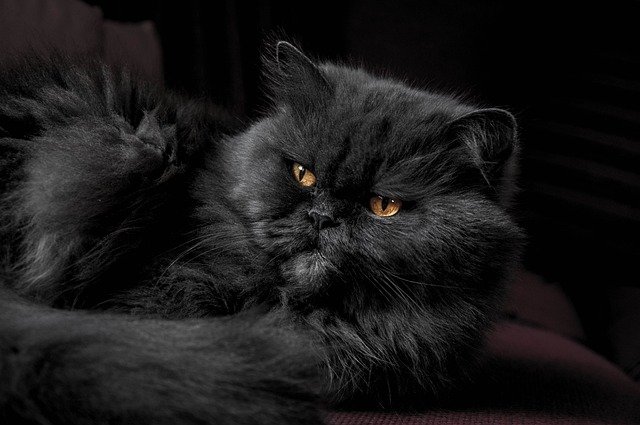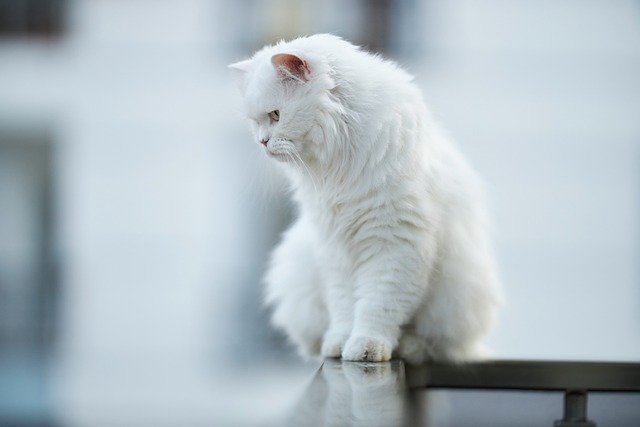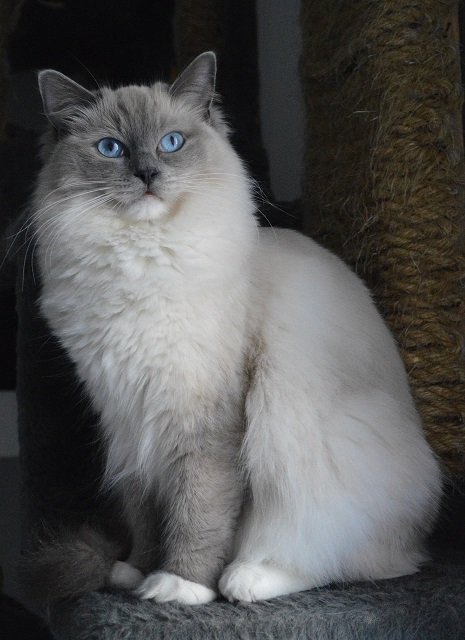The Ragdoll cat is known for its affectionate and calm nature, making it a popular breed among pet owners. However, these gentle felines are prone to certain health issues, particularly those affecting urinary system conditions like
- Cystitis
- Bladder stones
- infections
can lead to serious complications if not addressed early.
Since the urethra in females is close to the bladder, and in males, it is near the prostate, they are more likely to develop urinary tract infections (UTIs). A genetic predisposition, along with poor hydration and a diet high in salt and phosphorus, can further increase the risk.
Early detection is crucial, as UTIs often share common symptoms such as increased urination, pain, difficulties while urinating, and even blood in the urine. Cats may also show intensive licking of their genitals or urinate outside the litter box in unusual places.
A severe infection may cause fever, abdomen pain, and other bacterial diseases. To prevent UTIs, it is essential to keep your Ragdoll properly hydrated and maintain a low-salt, low-phosphorus diet. Regular vet checkups can help ensure any problems are detected and treated early, avoiding serious complications.
If symptoms arise, it is best to consult a vet as soon as possible for the right treatment options, including antibiotics, fluids, and nutritional therapy, ensuring your cat stays healthy and happy.
Overview of Ragdoll Cat UTI:
| Aspect | Details |
|---|---|
| What is UTI? | A urinary tract infection (UTI) is an infection of the urinary system, which includes the bladder, kidneys, and urethra. |
| Common Symptoms | Frequent urination, straining to urinate, blood in urine, discomfort while urinating, licking the genital area excessively. |
| Causes in Ragdolls | Bacterial infections, bladder stones, urinary blockages, dehydration, or underlying health conditions like diabetes or kidney disease. |
| Risk Factors | Poor hydration, obesity, stress, improper diet, and genetics. Ragdolls may be more prone due to their laid-back nature and potential weight gain. |
| Treatment Options | Antibiotics, pain relievers, and increased water intake. In some cases, surgery may be required for bladder stones or blockages. |
| Prevention Tips | Provide a high-quality diet, ensure access to fresh water, maintain a healthy weight, and reduce stress. Regular vet visits for early detection. |
| When to See a Vet | If symptoms persist for more than 24-48 hours, or if the cat is in pain, has blood in their urine, or seems lethargic. |
| Long-Term Care | Manage stress, maintain a proper diet, monitor urinary habits, and ensure regular vet check-ups for ongoing prevention. |
Understanding Ragdoll Health Problems
Table of Contents
Ragdoll cats have a calm and friendly nature, making them a popular breed among pet owners. However, they are susceptible to various health challenges that require careful management.

These cats frequently experience urinary tract infections (UTIs), kidney disease, and heart conditions, which can affect their overall well-being. Their urinary system, including the bladder, kidneys, ureters, and urethra, is prone to infections, inflammations, and bladder stones, leading to discomfort and potential complications.
Due to their genetic makeup, Ragdolls may develop urinary issues more frequently than other breeds. Signs such as frequent urination, pain, blood in the urine, and excessive licking of the genitals indicate an urgent need for veterinary care.
In addition to urinary problems, kidney disease caused by high salt and phosphorus levels in the diet and heart conditions such as hypertrophic cardiomyopathy (HCM) can be life-threatening. Preventative measures, including proper hydration, a balanced diet, and routine vet checkups, are crucial in reducing these risks.
Common Health Issues in Ragdoll Cats
Ragdolls are vulnerable to several health conditions, with urinary tract infections, kidney disease, and heart disorders being the most common.

UTIs develop when bacterial infections affect the urinary system, causing symptoms like pain, blood in the urine, and increased urination. If left untreated, these infections can lead to chronic bladder or kidney disease.
Kidney disease is another major concern for this breed, often resulting from dehydration, excess salt and phosphorus in the diet, or hereditary factors. Without proper management, kidney disease can progress to renal failure, severely impacting a cat’s health.
Additionally, Ragdolls are prone to heart disease, particularly hypertrophic cardiomyopathy, which thickens the heart muscles and makes it difficult for the heart to function properly. Regular veterinary checkups, a well-balanced diet, and proper hydration can help prevent these health issues from becoming severe.
How Genetics Influence Urinary Health in Ragdoll Cats
The genetic makeup of Ragdolls contributes to their higher risk of developing urinary problems. Their anatomy and physiology make them more susceptible to infections.

In females, the urethra is positioned close to the bladder, making it easier for bacteria to enter and cause inflammation. In males, the urethra is located near the prostate, increasing the risk of urinary blockages.
Obesity is another factor that raises the likelihood of urinary system disorders. A higher body fat percentage puts additional pressure on the bladder and kidneys, increasing the chances of UTIs and other complications.
Preventing these problems involves ensuring a properly hydrated diet, reducing salt and phosphorus intake, and scheduling regular veterinary checkups to detect early warning signs. Taking these precautions helps maintain the overall health of Ragdolls and minimizes the risk of serious conditions in the long run.
Ragdoll Cat UTI Symptoms
Urinary tract infections (UTIs) can be a serious concern for Ragdoll cats, leading to pain, discomfort, and potential complications if left untreated.
These infections occur when bacteria enter the urinary system, affecting the bladder, kidneys, ureters, or urethra. Due to their genetic predisposition and specific anatomy, Ragdolls may be more prone to urinary issues.
Identifying the signs early can help prevent more severe conditions, such as bladder inflammation or kidney infections.
Signs of a Urinary Tract Infection in Ragdoll Cats
If your Ragdoll has a UTI, you may notice several symptoms, including:
- Frequent urination or straining in the litter box – Your cat may visit the litter box more often but pass only small amounts of urine.
- Blood in the urine – Urine may appear pink or reddish due to irritation in the urinary tract.
- Excessive licking of the genital area – Cats try to soothe discomfort by grooming excessively.
- Crying or showing discomfort while urinating – Your cat may meow, whimper, or appear restless due to pain.
- Urinating outside the litter box – Infections can make cats associate the litter box with pain, leading them to urinate in unusual places.
In addition to these symptoms, your Ragdoll may also experience a loss of appetite, lethargy, or signs of dehydration.
If you notice any of these behaviors, it is crucial to consult a veterinarian as soon as possible. Early diagnosis and treatment can prevent complications and ensure your cat’s overall well-being.
Ragdoll Cat UTI Treatment

Urinary tract infections in Ragdoll cats require timely intervention to prevent serious health complications. While mild cases can sometimes be managed with home care, most UTIs need veterinary attention to ensure a full recovery.
Treatment varies depending on the severity of the infection, underlying causes, and the cat’s overall health. Along with medical treatments, preventive care plays a crucial role in reducing the chances of recurring infections.
Veterinary Treatments
When a UTI is suspected, a vet will perform diagnostic tests to determine the cause and severity. Common treatments include:
- Antibiotics and prescription medications – Bacterial infections are typically treated with antibiotics to eliminate harmful bacteria and reduce inflammation. Pain relievers may also be prescribed if the cat is experiencing significant discomfort.
- Diagnostic tests (urinalysis, ultrasound) – A urinalysis helps detect bacteria, blood, or crystals in the urine, while an ultrasound may be used to check for bladder stones or other abnormalities. In some cases, urine cultures are performed to identify the specific bacteria causing the infection.
Home Remedies & Preventive Care
While veterinary care is essential, certain home remedies and lifestyle adjustments can help manage and prevent UTIs in Ragdoll cats:
- Hydration and proper diet – Ensuring your cat drinks enough water can help flush out toxins and maintain bladder health. Feeding a high-moisture diet or specialized urinary health cat food can reduce the risk of infections and bladder stones.
- Litter box hygiene – Keeping the litter box clean and using unscented, dust-free litter encourages healthy bathroom habits and reduces bacterial exposure. Providing multiple litter boxes in a multi-cat household can also minimize stress-related urinary issues.
- Natural supplements – Some cat owners use cranberry extract and probiotics to support urinary tract health. While these supplements may help prevent infections, they should be used under veterinary supervision.
By combining medical treatment with proper care and preventive strategies, Ragdoll cat owners can help their pets maintain a healthy urinary system and reduce the risk of recurring infections.
Ragdoll Disease in Humans: Is It a Concern?
Ragdoll cats, like all pets, can carry certain bacteria and infections, but the risk of transmitting diseases to humans is generally low.
While urinary tract infections in cats are not contagious to humans, maintaining good hygiene is essential to prevent exposure to other potential zoonotic diseases.
Understanding how diseases spread between pets and humans can help cat owners take necessary precautions without unnecessary worry.
Can Humans Catch Infections from Ragdoll Cats?

Urinary tract infections in Ragdoll cats are caused by bacteria that affect their urinary system and do not pose a direct threat to humans.
However, other bacterial infections, such as those caused by E. coli or Salmonella, can sometimes be transmitted through contact with an infected cat’s feces, urine, or saliva. Proper sanitation and handling of litter boxes can minimize any risk of bacterial exposure.
Overview of Zoonotic Diseases
Although UTIs themselves are not a concern for humans, certain diseases can be transmitted from cats to people, including:
- Cat scratch disease (Bartonellosis) – Caused by bacteria transmitted through scratches or bites, leading to swollen lymph nodes and flu-like symptoms.
- Ringworm – A fungal infection that causes itchy, circular skin rashes and can spread through direct contact with an infected cat’s fur.
- Toxoplasmosis – A parasitic infection found in cat feces, which can pose risks to pregnant women and individuals with weakened immune systems.
Hygiene Tips for Cat Owners
To reduce the risk of infection, cat owners should follow simple hygiene practices:
- Wash hands thoroughly after cleaning the litter box or handling cat waste.
- Regularly disinfect litter boxes and feeding areas.
- Keep cats indoors to reduce exposure to external parasites and diseases.
- Schedule routine veterinary checkups to monitor for any potential health issues.
While Ragdoll cats are not a significant health risk to humans, maintaining good hygiene and responsible pet care ensures a safe and healthy environment for both cats and their owners.
Ragdoll Cat Price: How Health Factors Affect Cost
Ragdoll cats are a sought-after breed known for their gentle temperament and striking appearance, but their price can vary widely based on several factors.

The cost of a Ragdoll cat typically ranges between $800 and $3,000, depending on the breeder, location, and lineage.
Beyond the initial purchase price, prospective owners should also consider long-term health-related expenses, as this breed is prone to specific medical conditions.
Breakdown of Ragdoll Cat Prices
Several factors influence the price of a Ragdoll cat, including:
- Breeder reputation – Ethical breeders charge higher prices due to responsible breeding practices and health screenings.
- Pedigree and lineage – Show-quality or purebred champion bloodlines cost more than pet-quality cats.
- Location – Prices vary by region, with higher costs in areas where demand for the breed is strong.
- Age and coat color – Kittens are typically more expensive than adult cats, and rare coat colors may increase the price.
How Health Screenings and Veterinary Care Affect Ownership Costs
Ragdoll cats are predisposed to certain health conditions, such as hypertrophic cardiomyopathy (HCM) and urinary tract issues.
Reputable breeders invest in genetic testing and early health screenings, which can increase the upfront cost but help prevent expensive medical bills later. Owners should also budget for:
- Routine vet visits – Regular checkups, vaccinations, and preventative care.
- Emergency medical care – Unexpected health issues like kidney disease or bladder infections.
- Specialized diets – Some Ragdolls require urinary health cat food to prevent infections.
Importance of Choosing a Reputable Breeder
Selecting a responsible breeder ensures that the cat has been tested for common genetic conditions, reducing the risk of future health problems.
Ethical breeders provide medical records, early socialization, and health guarantees, which can save owners from costly veterinary expenses. Avoiding backyard breeders and pet mills is essential to getting a healthy and well-cared-for Ragdoll cat.
While the initial cost of a Ragdoll cat may seem high, investing in a healthy kitten from a responsible breeder can lead to fewer medical issues and a better quality of life for both the pet and the owner.
Conclusion
Urinary tract infections in Ragdoll cats can cause significant discomfort, with symptoms like frequent urination, blood in the urine, and excessive licking. Early detection is essential, as untreated infections can lead to serious complications.
Veterinary treatments such as antibiotics and prescription medications, along with diagnostic tests like urinalysis and ultrasounds, play a crucial role in effective recovery.
Prevention is key to maintaining a Ragdoll cat’s urinary health. Providing a well-balanced diet with urinary health cat food, ensuring proper hydration, and maintaining litter box hygiene can reduce the risk of infections. Natural supplements like cranberry extract and probiotics may also support bladder health.
Regular vet checkups help catch potential health issues before they become severe. Owners should stay informed about their cat’s health and be proactive in seeking medical advice when needed.
To support your Ragdoll’s well-being, explore vet-approved urinary health diets and recommended treatments for optimal care.
Frequently Asked Questions
Are UTIs common in Ragdoll cats?
Yes, urinary tract infections (UTIs) are relatively common in Ragdoll cats. Their genetic predisposition, along with factors like diet, hydration levels, and litter box hygiene, can increase the risk of developing UTIs.
What is the most common disease in Ragdoll cats?
Ragdolls are prone to several health conditions, but hypertrophic cardiomyopathy (HCM) and kidney disease are among the most common. Urinary tract issues, including infections and bladder stones, are also frequently observed in this breed.
What breed of cat is prone to UTI?
Certain breeds, including Ragdolls, Persians, and Siamese cats, are more prone to urinary tract infections due to their genetic makeup and susceptibility to urinary tract diseases.
How can I tell if my cat has a UTI?
Signs of a UTI in cats include frequent urination, straining in the litter box, blood in the urine, excessive licking of the genital area, and crying or discomfort while urinating. Sudden urination outside the litter box can also indicate a problem.
How to treat a cat’s UTI at home?
While veterinary treatment is necessary, home care can help manage symptoms. Ensure your cat stays hydrated, offer a specialized urinary health diet, and maintain a clean litter box. Some owners find natural supplements like cranberry extract beneficial, but always consult a vet first.
Can a dirty litter box cause UTI?
Yes, a dirty litter box can harbor bacteria, increasing the risk of urinary tract infections. Regular cleaning and providing multiple clean litter boxes can help prevent infections.
Can a cat’s UTI go away by itself?
Mild cases might improve with increased water intake, but most UTIs require veterinary treatment. Without proper care, the infection can worsen and lead to serious complications like kidney disease.
Is smelling cat pee bad for you?
Prolonged exposure to concentrated ammonia in cat urine can cause respiratory irritation, headaches, and dizziness, especially in poorly ventilated areas. Keeping litter boxes clean reduces odor and health risks.
What is the best litter to avoid UTI?
Unscented, low-dust, and clumping litter made from natural materials like corn, wheat, or paper can be gentler on a cat’s urinary system. Some litters are specifically designed to promote urinary health by reducing moisture and bacterial growth.
Previous Posts:

